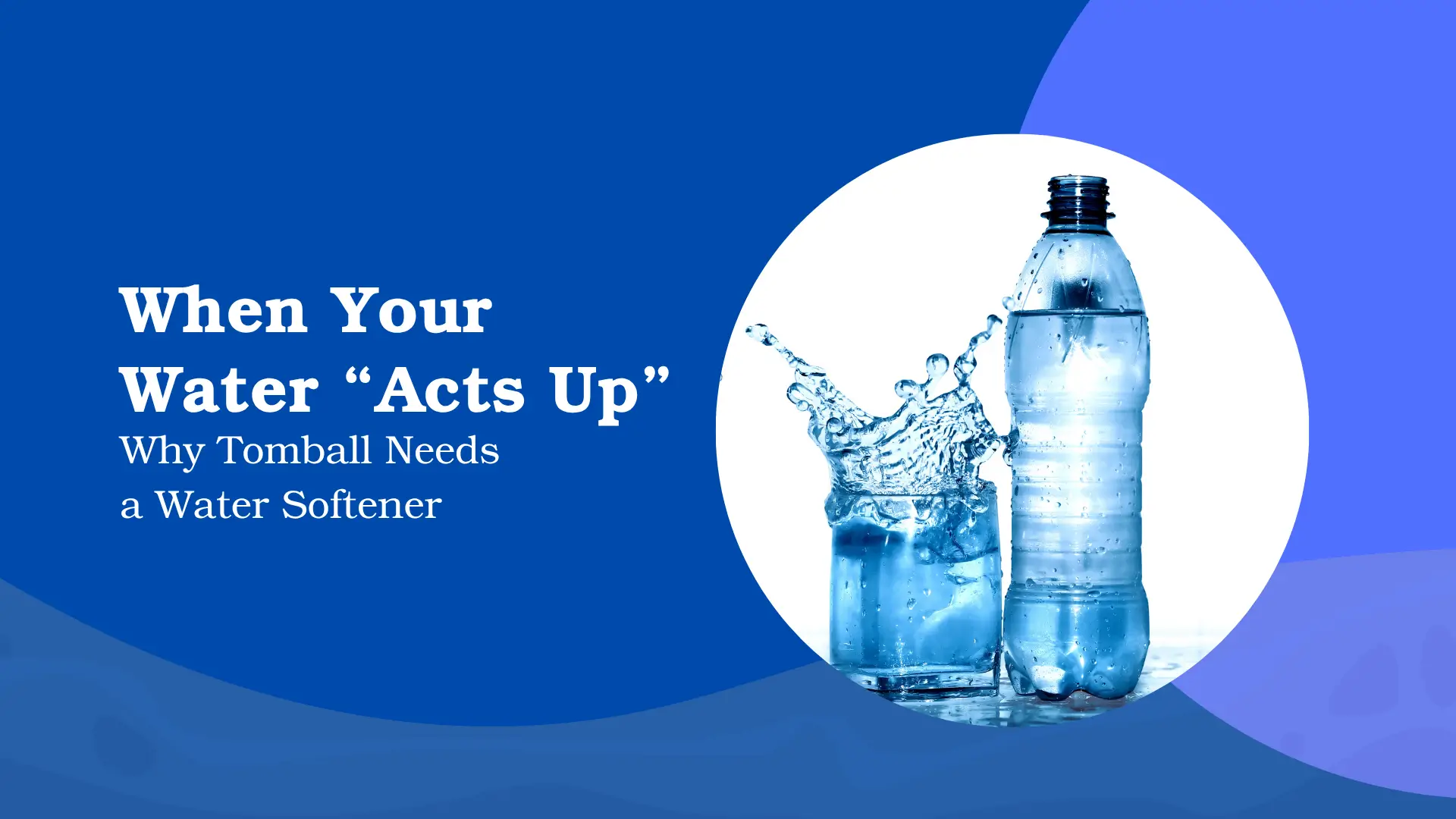Living in Tomball, Texas, comes with many perksbreezy summers, friendly neighborhoods, and (most days) reliable city utilities. But when it comes to water, there are quirks many residents don’t realize until scale, spots, or appliance issues start nagging at them.
In short: you may not need a water softener, but chances are your plumbing and appliances would benefit from oneespecially if you maintain it well.
This post is your down-to-earth guide to water softener maintenance, with a focus on Tomball’s water quality, local water concerns, and actionable steps. Plus, you’ll see how Aquapure’s Texas-based, homeowner-friendly approach fits in naturally.
What’s Actually in Tomball’s Tap Water?
Before we talk maintenance, it’s vital to understand what you’re softening against. The City of Tomball publishes an Annual Drinking Water Quality Report, which shows that its water meets all federal and state standards. That said, meeting standards doesn’t mean the water is free of practical nuisances. A few things tend to show up in local reports or in nearby utility systems:
- Hardness minerals (calcium and magnesium): These are naturally present as water filters through underground formations. In the Houston/Tomball region, hardness is often moderate to highHouston’s water is reported around 135 mg/L (~7.9 grains per gallon). While the City of Tomball doesn’t always list a precise number in every report, local utilities serving the area frequently fall in a similar hardness range.
- Arsenic (trace amounts): The EWG’s compilation of Tomball’s utility data notes that arsenic has been detected at around 1.45 ppb (parts per billion) well under the federal limit of 10 ppb, but above some more stringent guidelines.
- Sediment, turbidity, and occasional iron or manganese: Some local “muddy tap” or cloudy water reports come during rains or pipe disturbances. Smaller utilities or wells often report slight turbidity or sediment in their Consumer Confidence Reports.
- Disinfectant residuals (chlorine or chloramines): Like most municipal water systems, Tomball adds disinfectants to prevent microbial growth in pipes. These residuals can affect taste and react with organic compounds, forming minor byproducts. The annual report confirms disinfectant usage, though levels remain within regulatory limits.
- Other trace contaminants: VOCs, heavy metals, and occasionally Nitrate or others appear in utility reportsthough typically at levels deemed “safe” by regulations.
So, what your water isn’t is totally pure or perfectly “soft.” You and your neighbors are dealing with hardness, minor traces, and disinfectant chemicalsthe very things a well-maintained water softener (plus filtration) can help tame.
“Why Bother?”: Real Effects on Appliances, Health & Your Daily Life
What does hardness or mild sediment “do to your life”? The impacts sneak in quietly, but over time they add up:
- Limescale buildup in pipes, faucets, and showerheads
The calcium/magnesium deposits gradually choke pipe interiors, restrict flow, raise pressure drop, and reduce lifespan of fixtures. Spotting a slow trickle at your showerhead? Scale buildup might be starving the spray holes. - Reduced efficiency (and higher energy bills)
Water heaters have to work harder when scale insulates heating elements from the water. You may notice your heater cycling more or bills creeping upward. - Spotting, film, and soap scum
Dishes, glassware, tubs, faucetsall get that cloudy film or fail to sparkle, even after rinsing. - Shortened lifespan of appliances
Dishwashers, washing machines, ice makersscale can reduce their operational life and increase repair frequency. - Detergent inefficiency
Soap, shampoo, and cleaners don’t lather or rinse properlyso you may use more product and still feel residue on your skin or hair. - Taste or odor issues
While hardness itself doesn’t pose a health threat, chlorine, byproducts, or trace contaminants (like arsenic) can subtly affect taste, odor, or long-term chemical exposure. - Health & aesthetic effects
Hard water sometimes contributes to dry skin or hair, though evidence is mixed. More importantly, trace contaminants (even at safe levels) motivate many homeowners to reduce exposure if possible.
So yes, even though Tomball’s water “passes” regulatory tests, local conditions mean most homes benefit from softening and filtrationespecially if the system is maintained properly.
How to Know If Your Home Actually Needs Maintenance (or a System)
You don’t need a PhD to spot signs that your water is acting up. Here’s what to watch for:
Visible clues:
- Persistent white or gray film on faucets, showerheads, glassware, or inside kettles.
- Cloudy or cloudy water, especially after disturbances or pipe work.
- Brown, reddish, or rusty sediment occasionally coming through.
- Pinholes or leaks in plumbing joints (scale-induced corrosion).
Performance clues:
- Decreased water pressure or slower flow in older fixtures.
- Appliances showing scale inside, or requiring descaling more often.
- A gritty feel on your skin, soap not lathering, hair that seems dull or residue-laden.
- Water heater struggling, or needing more frequent maintenance.
Chemical / taste clues:
- Chlorine or bleach taste or odor, especially near faucets or after stagnation.
- Slight metallic or chemical aftertaste (sometimes a sign of trace metals or byproducts).
If you observe one or more of those, it’s time to test.
Test First: Your Starting Point for Smart Decisions
Before you buy or maintain anything, you’ll want hard data from a water test. Here’s a practical plan:
- Obtain your latest city or utility Consumer Confidence Report
The City of Tomball, for example, publishes an annual water report.
That gives you baseline levels of contaminants, though it may not cover what your household plumbing adds or what happens post-treatment. - Do a home water test
Use a kit (for TDS, hardness, chlorine) or send to a lab (for arsenic, metals, VOCs). Many kits are inexpensive and easy to use.- Test for hardness (mg/L or grains per gallon)
- Test for chlorine or disinfectant residual
- If desired, test for arsenic, lead, iron, etc.
- Schedule a technician evaluation
A certified water specialist can inspect your plumbing, measure flow/pressure, and see whether a softener or filtration makes sense for your home layout.
Starting with data helps you choose what capacity softener or filter you need, and prevents “overspending” on overly robust systems.
Keeping Your Water Softener in Top Shape: Maintenance Basics
Once you’ve chosen and installed a water softener or filtration system, maintaining it ensures everything runs smoothly for years. Here are friendly, practical tips:
1. Salt Check & Top-Up Regularly
If your system is salt-based (typical ion-exchange softeners), check the salt level at least once a month. Never let the salt drop so low that the tank goes dry. Use high-purity salt (pellets or blocks, not rock salt) to reduce impurities and bridging.
2. Clean the Brine Tank Annually
Salt can cake, form crusts, or bridge (a hollow shell of salt that prevents proper dissolution). Use warm water and scrubbing (when system is off) to gently cleanse the bottom. Break up any bridges by hand (safely).
3. Regeneration Timing
Most softeners regenerate automatically based on water usage or timers. But if your household size or usage changes, adjust the regeneration frequency. Too frequent → wasted salt, too infrequent → softening failure.
4. Sanitize Occasionally
Every 12–24 months, disinfect your unit with a mild bleach solution (per manufacturer instructions) to prevent bacterial growth in the brine tank or resin. Flush thoroughly afterward.
5. Monitor Performance Trends
Keep a log (even a small notebook). Track salt consumption, flow rate, water hardness after softener (test outlet once in a while), and any alerts or faults. Sudden changes are early red flags.
6. Change Pre-Filters or Sediment Traps
If your system has a pre-filter or sediment trap before the softener, change or flush it as needed. Otherwise sediment can clog the softener or abrade resin beds.
7. Inspect Resin Bed or Media (Long-Term)
After 8–10 years, the resin beads in your softener may start to lose capacity. A qualified technician can test and, if needed, recondition or replace resin media.
8. Watch the Bypass Valve
Make sure your bypass valve (used when doing plumbing work or islanding the softener) is functioning and properly sealed. Never leave it open inadvertentlywater may bypass treatment completely.
9. Seasonal Adjustments
In colder months, check for any freezing risk (if your softener is in an unconditioned space). Also, after heavy rainfall or nearby construction, flush lines if you see turbidity or sediment surges.
10. Keep Documentation and Warranty Updated
Aquapure (and many quality vendors) offer lifetime warranties when the system is serviced by certified technicians. Make sure you’re in compliance (use recommended parts, keep service logs) so your warranty stays valid.
Through these steps, a typical softener system can run at peak for 10–15 years with minimal trouble.
How Filtration and Softening Can Work Together
A softener handles hardnessthe calcium and magnesium ionsbut doesn’t remove chlorine, arsenic, VOCs, or trace metals. That’s where a filtration system complements it.
- Activated carbon filters (often placed before or after the softener) remove chlorine, taste/odor compounds, and many organic chemicals.
- Sediment filters before the softener protect it from grit or particulate matter.
- Reverse osmosis (RO) or advanced media filters can tackle arsenic, lead, or other contaminants when test results show they’re needed.
If you’re curious about those, check out Aquapure’s water filtration offering (link to their home filtration system page). It’s a natural fit with your softener setup.
By combining softening + filtration, you can enjoy:
- Spotless dishes, better soap performance
- Cleaner taste and odor
- Balanced hardness protection for appliances
- Safer trace contaminant exposure
Why Many Tomball Homeowners Prefer Aquapure
You won’t see pushy sales talk here, but it’s worth knowing your local options. Aquapure is Texas-owned, family-operated, and has served the region for over a decade. Their model offers some homeowner-friendly features:
- Free installation & support by certified technicians
- $0 down / easy financing / Buy Now – Pay Later
- Lifetime warranties, provided service conditions are met
- Custom solutions that match your home’s water usage, plumbing layout, and water test results
Because they’re local, their teams also understand regional quirks: foundation soils, seasonal rain runoffs, utility water sources, and Texas climate demands.
If you start with a free water test or quote, you can see if a solution makes sense without commitment. (I’ll invite that again at the end.)
Maintenance Scenarios: What to Do When Things Go Off Track
Even the best system has hiccups. Here are real-world issues you might seeand how to troubleshoot:
| Problem | Likely Cause | What to Do |
| Softener no longer seems effective (hard water “breakthrough”) | Resin bed exhausted, salt bridging, malfunctioning valve | Check salt level, clear bridge, run a manual regeneration. If still poor, call technician to test resin capacity. |
| Drain backup or overflow | Clogged drain lines, improper setup | Flush line, inspect drain height/clamp, ensure no backflow issues. |
| Unnatural taste or smell | Brine tank contamination, new salt impurity | Sanitize brine, flush well, replace with high-quality salt. |
| Sudden drop in pressure or flow | Scale clog downstream, fouled pre-filter, valve issue | Inspect pre-filter, clean or replace, test bypass valve position. |
| High salt usage | Over-regeneration, leak, control error | Lower regeneration frequency or check control settings, inspect for leaks or control faults. |
If any issue persists more than a week or two, call a certified technicianespecially if your system is covered by lifetime warranty.
Local Considerations & Tips for Tomball Homeowners
- Beware of utility switchovers or pipe work
Occasionally Tomball pipes undergo maintenance or repairs. After such work, flush your lines before counting on your softener; sediment surges can damage media. - Consider well or common MUD areas
Some neighborhoods near Tomball may rely on MUD or private water systems. Those sometimes show higher turbidity, iron, or manganese. If you’re on a private well, test even more frequently. - Tomball’s experience with “boil water” alerts
The city has issued boil-water notices in past years (e.g. during main breaks). During and after such events, bypass or protect your system until you confirm water quality. - Work with local code & plumbing constraints
Because Texas air temperatures and construction styles differ from other regions, installers need to ensure units are protected from freezing (rare, but possible in shade) and that salt brine lines have proper routing. - Take advantage of local warranties & service coverage
Using a local company like Aquapure often means faster service, parts stock, and qualified technicians familiar with Houston/Tomball area plumbing.
Local FAQ for Tomball (and Nearby Katy, Spring, Houston Areas)
Q: Is Tomball tap water safe to drink?
Yesaccording to the City’s 2024 Water Quality Report, the water meets or exceeds all regulatory standards. That said, “meeting standards” doesn’t necessarily remove every nuisance compound or trace chemical you might want filtered.
Q: Do I need a water softener in Tomball?
If you’re seeing scale, film, hard-to-lather soap, or if your appliances are showing signs of mineral buildupyes, a softener can help a lot. Many homes in the Houston metropolitan area face water hardness in the 120–140 mg/L range, which is enough to cause practical problems.
Q: How much does a water softener cost in this region?
That depends on system size, media quality, and installer. But with financing, $0 down promotions, and lifetime warranties, many homeowners find that the monthly cost is similar to a utility surcharge and offset by reduced energy/repair bills.
Q: Will a softener remove rust, sediment, or arsenic?
Noion exchange softeners don’t target those. That’s why pairing a softener with sediment filters, carbon filters, or specialty media is wise. In the case of arsenic (if tests show it), you’d use a specific arsenic filter or RO system.
Q: When should I get a free water test or quote?
As soon as you suspect water issuesscale on faucets, appliance scaling, or spotty glassware. A baseline test helps you choose the right system the first time. Many local providers (like Aquapure) offer free testing, so you have nothing to lose.
Final Thoughts & Invite
A well-chosen and properly maintained water softener can transform your home experience: smoother surfaces, better soap performance, longer appliance life, and a touch of peace knowing your water is under control.
If you live in Tomball and want help designing a system, testing your water, or understanding what fits your home best, feel free to request a free water test or quote from Aquapure. No pressurejust helpful guidance from locals who know Texas water quirks



